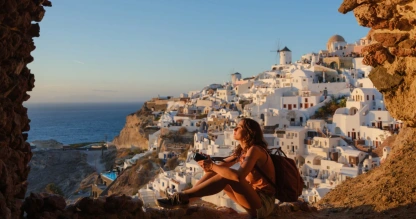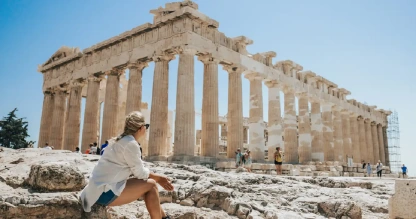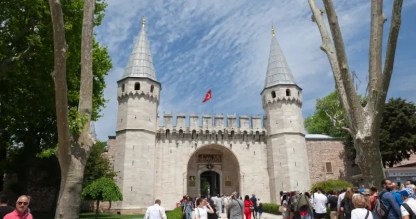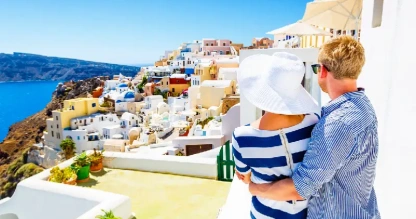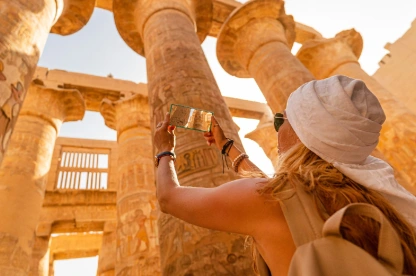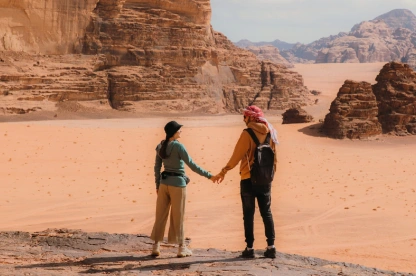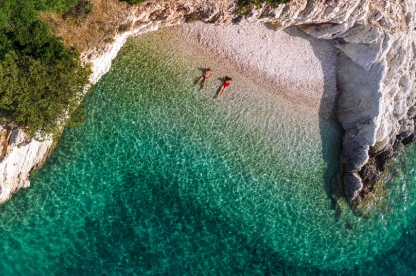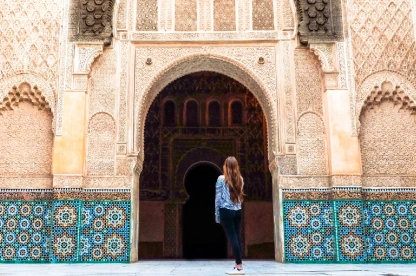Table of Contents:
Walking Through History: Top Ancient Ruins in Greece
Greek ruins stand as remarkable evidence of one of the greatest civilizations of all time. A few of them have been continuously occupied for over 3,000 years. The legendary Acropolis sits on its rocky hill overlooking Athens, and the complete Theater of Epidaurus held 16,000 spectators. These architectural marvels continue to fascinate visitors from around the world.
The historical sites in Greece have aesthetic appeal beyond them—they open windows into pivotal moments of human development. Olympia's old stadium bore witness to the first Olympic Games in 776 BC and seated approximately 50,000 spectators. The Temple of Apollo, built during the 4th century BC[-3], was a ceremonial hub that saw ancient Greeks interact with their gods.
This article explores Greece's greatest historcal sites. Each site tells a unique story of artistic achievement, religious devotion, and innovative ideas that shape our world today.
Ancient Athens: The Heart of Classical Greece
Athens is the hub of Greece's archeological marvels. Ancient ruins there tell engaging stories of democracy's genesis and classical civilization's golden age. These ancient places show artistic, philosophical, and political achievements that shaped Western civilization.
Acropolis and the Parthenon
A rocky outcrop above Athens cradles the Acropolis, which contains Greece's finest architectural jewels. There were people living here from the 4th millennium BC, but the most marvelous structures emerged in the 5th century BC in the time of Pericles. The resplendent Parthenon, built between 447-438 BC, was a temple to Athena Parthenos.
Tourists climb to the Propylaea, a beautiful gateway made out of Pentelic marble. Temple of Athena Nike crowns the south. Erechtheion boasts the north with its Caryatids - beautiful female figures that support the temple's southwest porch.

Ancient Agora and the Temple of Hephaestus
The Ancient Agora lies under the Acropolis. The crowded square once pulsed with life as Athens' business, government, and society hub. Democracy flourished as courts met, laws were made, and citizens gathered to debate.
The Temple of Hephaestus dominates the Agora skyline. Greece's best-preserved ancient temple was completed circa 449 BCE to honor Hephaestus, the god of fire and craftsmanship. The temple surprisingly endured relatively well because it was used as a church for Saint George's Greek Orthodox church until 1834.

Theater of Dionysus and Temple of Zeus
Dionysus' Theater is located on the Acropolis' south slope. The Western theater began here in this 6th-century BC amphitheater that had a seating capacity of 17,000. The popular playwrights Sophocles, Euripides, and Aristophanes introduced their plays here during the festivals honoring Dionysus.
Just below the Acropolis is situated the majestic Temple of Olympian Zeus. Construction commenced in the 6th century BCE and remained incomplete until Roman times. The massive temple originally featured 104 colossal columns, though today there are just 16 that remain piercing the sky.

Peloponnese Wonders: Olympia to Mycenae
Peloponnese is home to some of the most important ancient ruins in Greece. Each of these locations tells its own story of Hellenic civilization in the forms of athletic competitions, military defenses, and theater performances highlighting the great work of ancient Greek society.
Olympia and the beginnings of the Olympic Games
Olympia is Greece's greatest ancient shrine where the Kladeos and Alpheios rivers converge in a fertile landscape. The sanctuary of Zeus was the site of origin of the Olympic Games in 776 BC.
The stadium lies at the heart of Olympia, where athletes meet every four years in order to honor Zeus. Athletes competed in a 192-meter-long race while 40,000 spectators watched. Early spectators sat on sloping ground, and only judges filled stone seats.
Zeus's temple, the largest in the Peloponnese, draws tourists along with other impressive structures like Hera's temple, Philippeio, and Palaestra. UNESCO scores Olympia as the ancient archeological site most closely linked to our modern-day world.
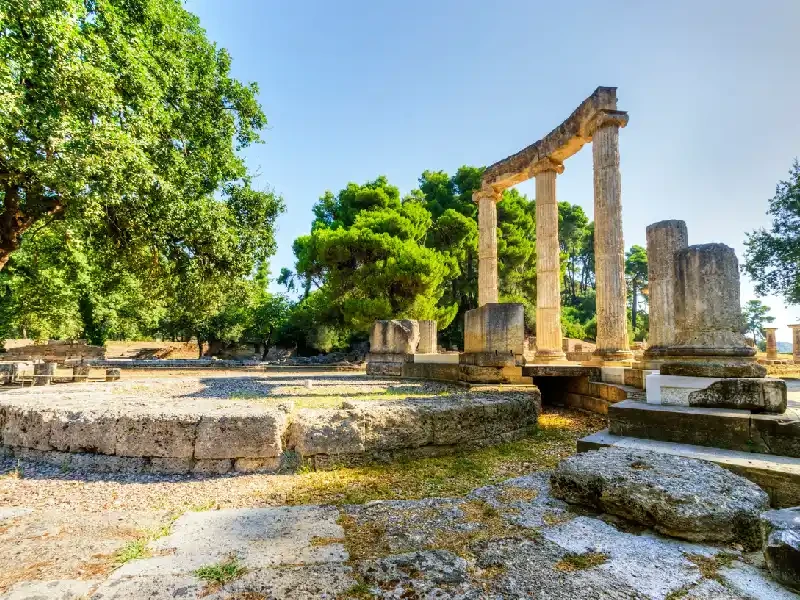
Mycenae and the Lion Gate
A must-see on many Greece trips, Mycenae's powerful citadel controlled southern Greece, Crete, and southwest Anatolia. The citadel was at its height around 1350 BC when 30,000 inhabitants occupied its 32 hectares.
The Lion Gate, famous from an early time, has been the main entrance to this Bronze Age city since 1250 BC. Towering above is 3.10 meters broad and 2.95 meters high and features two facing lionesses sculpted above its huge lintel. It is the only remaining piece of monumental Mycenaean sculpture.
Huge Cyclopean walls surround the site. Ancient Greeks claimed that only legendary one-eyed giants could move such ginormous stones.
Theater of Epidaurus
The best acoustical ancient Greek theater was created by architect Polykleitos the Younger between 340-300 BCE. The Theatre of Epidaurus sits on the western slope of Cynortion Mountain and accommodated up to 14,000 spectators.
The sound is transmitted perfectly through this masterpiece. Even a stage whisper can be heard in each and every seat. The limestone benches do this amazing acoustics by filtering out low frequencies and reflecting high frequencies.
The theatre played an important role in the sanctuary of the healing god Asclepius. The drama was believed to heal both body and mind by the ancient Greeks.
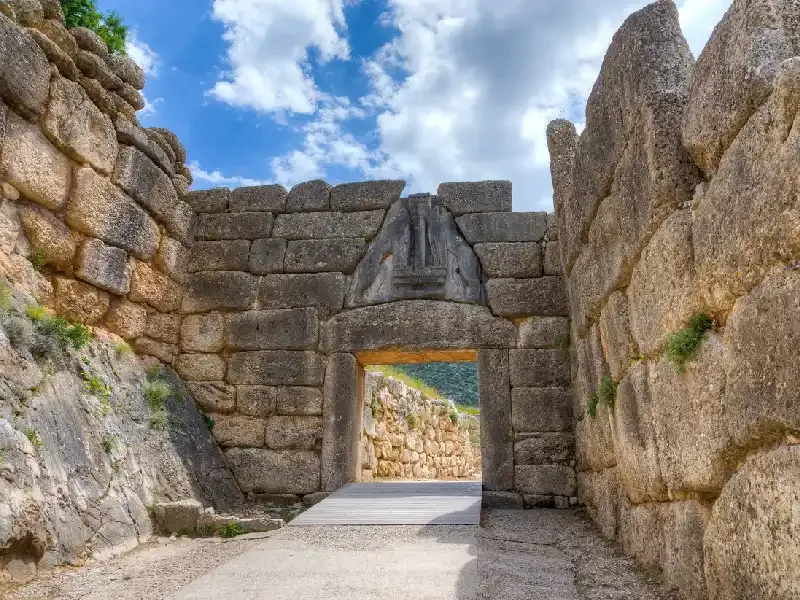
Sacred Historical Sites in Greece: Delphi and Beyond
Delphi sits majestically between Mount Parnassus's towering rocks. Ancient Greeks called it the "navel of the world" - the spot where Zeus's two eagles crossed paths. This pan-Hellenic sanctuary grew into a powerful spiritual and political hub starting in the 8th century BC.
Temple of Apollo at Delphi
The Temple of Apollo, which housed the famous oracle, went through many rebuilds over time. Today's ruins come from the 4th century BC. The Pythia, a woman above 50 who lived separately from her husband, would reach a trance-like state here.
Natural gasses from geological faults under the temple might have triggered these states. Her prophecies shaped decisions about wars and even farming schedules.
The Athenian Treasury and Sacred Way
Greek city-states built many treasuries along the Sacred Way that led to Apollo's temple. The Athenians built their treasury after 490 BC to celebrate their victory at Marathon. This treasury stands out as the first Doric structure made from Parian marble. Its walls feature many inscriptions, including Apollo's hymn that now rests in the Delphi Museum.

Tholos of Athena Pronaia
The magnificent Tholos of Athena Pronaia stands about half a mile from the main site. Builders completed this structure between 380-360 BC. This round masterpiece showcased 20 Doric columns outside and 10 Corinthian columns inside.
Three restored columns make it Delphi's most captured sight by photographers. Builders used Parian and Pentelic marble with blue Eleusinian limestone to create a beautiful multicolored effect.
Island Treasures: Minoan and Cycladic Civilizations
The Aegean islands beyond mainland Greece were home to remarkable civilizations that left amazing archeological treasures. These island communities built sophisticated societies that prospered through sea trade and created their own unique artistic and architectural styles.
Knossos Palace in Crete
Europe's oldest city, Knossos, spans six square miles and stands as Greece's largest Bronze Age site and is a must-see on any Greece tour. The magnificent palace covered about five acres and became the heart of Minoan civilization. The complex featured a detailed layout with multiple stories, advanced drainage systems, and spaces for ceremonies.
The palace's maze-like design probably gave rise to the famous Minotaur myth. Its architectural wonders included a stunning Throne Room with a gypsum chair, huge storage areas, and busy workshops. The walls showcased bright fresco paintings that captured scenes of nature, religious rituals, and sea life.
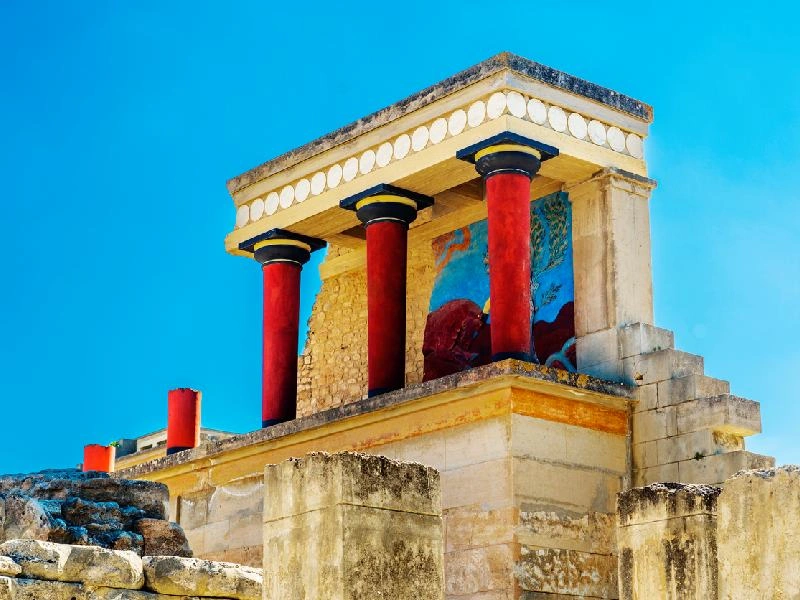
Akrotiri of Thera in Santorini
Santorini island's Akrotiri thrived as another spectacular Minoan settlement. This Bronze Age town grew into one of the civilization's busiest urban centers until a volcanic eruption buried it under ash in the 17th century BC. The site remained preserved like in Pompeii, Italy for more than 3,700 years.
Delos and the Terrace of the Lions
Delos, a small rocky island near Mykonos, ranks among Greece's most valuable archeological sites. People revered it as Apollo and Artemis's birthplace, and Delos grew from a sacred site into a busy Roman-era port before people abandoned it.
The island's famous Terrace of the Lions originally featured 9-12 marble guardian beasts dedicated to Apollo around 600 BC, though only seven remain today. These majestic marble lions created a grand avenue that rivaled Egyptian sphinx-lined paths.

How to prepare for your visit
The right preparation will give a more rewarding experience when visiting Greece's archeological treasures. Your best strategy is to reach these sites right at 8am opening time or after 3pm to avoid crowds and heat. You can skip long entry lines by booking tickets online before your visit.
Comfortable footwear plays a crucial role since Greek historic sites have steep paths, uneven ground, and lots of steps. The right clothing makes a big difference too - pack light, breathable fabrics for summer, layers for spring and fall, and warm clothes with rain gear for winter visits.
Of course, you need sun protection whatever the season. Pack hats, sunglasses, and sunscreen, especially at exposed sites where sunlight bounces off marble surfaces. Most archeological sites don't have food or drink vendors inside, so bring water and snacks with you.
Local guides are a great way to get deeper insights into these ancient wonders and they can answer your questions. Your trip becomes richer when you pair site visits with nearby museums, like seeing the Heraklion Archeological Museum after Knossos.
The best time to visit is during late spring (April-June) or early fall (September-October). These months have milder temperatures and nowhere near as many tourists as peak summer.
Frequently Asked Questions
Q1. What is the most famous ruin in Greece?
The most famous ancient ruin in Greece is undoubtedly the Parthenon on the Acropolis of Athens. This iconic structure is a symbol of classical civilization and one of the most visited historical sites in Greece.
Q2. How many ancient ruins are there in Greece?
Greece is home to thousands of ancient ruins, from well-preserved temples to forgotten sanctuaries. Every region offers a unique glimpse into the past, making it a paradise for those passionate about ancient ruins in Greece.
Q3. Which Greek island is best for ancient ruins?
Delos is often considered the best Greek island for exploring ancient ruins. Once a thriving religious center, it now offers some of the most impressive and untouched historical sites in Greece, including temples, mosaics, and theaters.
Q4. What is the oldest site in Greece?
The Palace of Knossos in Crete is among the oldest known historical sites in Greece, dating back to the Minoan civilization around 1900 BC. It showcases the early complexity of architecture and urban planning in ancient times.
Q5. What is the best way to travel in ancient Greece?
To explore ancient ruins in Greece, the best way to travel is by combining guided tours and self-exploration. Many historical sites in Greece are accessible by car or regional bus, especially in mainland areas like Athens, Delphi, and the Peloponnese.
Q6. What are some travel tips for Greece?
When visiting historical sites in Greece, wear comfortable shoes, carry water, and start your tours early to avoid the heat. Respect protected ancient ruins in Greece by not climbing or touching delicate structures.
Ready to explore Greece and the best destinations in the Middle East? Book your Greece trips now!
Find Other Blogs
Explore the 10 best things to do in Dubai, from world-famous sights and thrilling adventures to unique cultural experiences for every type of traveler.
Explore the best destinations in Middle East, from ancient wonders to modern marvels, perfect for culture lovers, adventure seekers, and beach fans alike.
Explore the timeless wonders of Egypt, from ancient pyramids to majestic temples, in this ultimate guide to the country’s most iconic sites.
Explore the magic of Wadi Rum, Jordan’s desert gem filled with red sands, towering cliffs, and unforgettable Bedouin adventures.
Get ready for your trip with these essential Turkey travel tips, covering culture, food, key sights, and must-know advice for first-time visitors!
Discover the rich flavors of Moroccan cuisine: tajines, couscous, street bites, and sweet treats you won't want to miss!
Discover the best beaches in Greece, from hidden gems to iconic shores, on unforgettable Greece tours filled with sun, sea, and stories.
Discover the most visited places in Istanbul, including top sites, historic landmarks, and must-see spots in this vibrant city.
Experience the thrill of a Dubai desert safari with dune bashing, camel rides and sunset views in one unforgettable adventure.
Explore the imperial cities of Morocco, Fez, Marrakesh, Rabat, and Meknes and experience rich history, culture, and stunning architecture.


